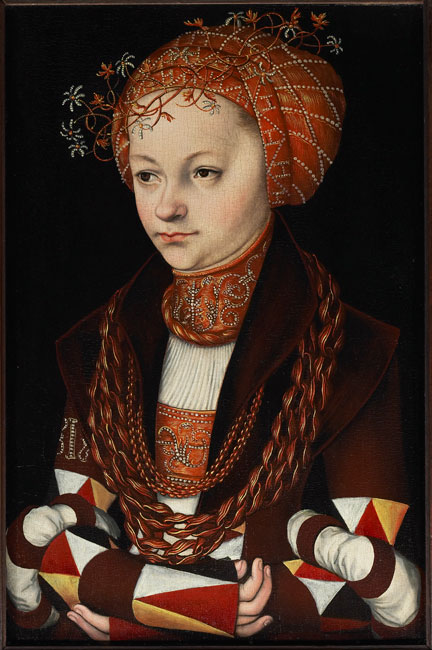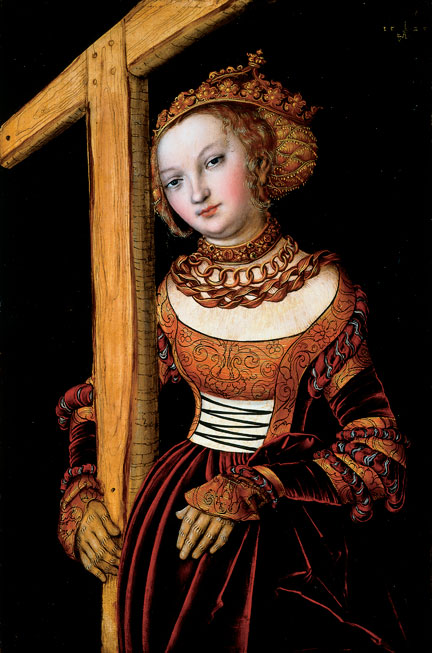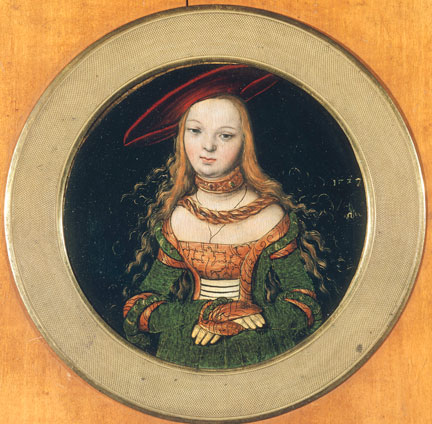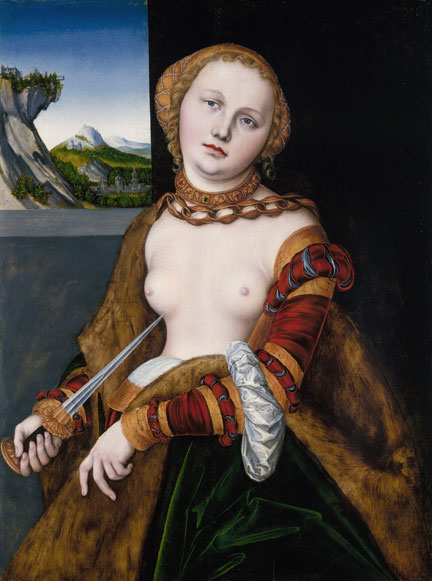Subject
The woman is placed against a black background. She wears a dress of dark red material with the appearance of velvet. The collar is lined with black. The upper and lower parts of her slashed sleeves are separated by the white fabric of her undergarment, over which are vertical black lines which may indicate laces joining upper and lower sleeves. The white material is also visible under black lacing above her waist. Her sleeves are ringed with several bands of gold, decorated with patterns of black, and end with long cuffs of the same textile. Her bodice is low-cut, drawing attention to her full but subtly indicated breasts. The orange textile of the upper part of her bodice may be intended to represent cloth of gold; on it is a diamond pattern made up of pearls, with further pearls representing the letter M repeated several times within the diamonds. Her headdress is made of a similar material to the bodice, lacking the pearl design. She wears a large gold chain over her bodice, which rests on her shoulders, while the opening of her collar reveals a narrow gold band worn around her neck with, above it, a similarly close-fitting jewelled collar. She wears white gloves with slashes at the knuckles, and rings on her fingers, which glint through the slashes. In addition she is wearing over her gloves three rings on the fingers of her left hand and two on her right, though it would appear to have been impossible for these rings to pass over those worn under the gloves.6 Her hair is fair and her eyes are brown.
NG291 is usually described as a portrait, yet it has characteristics in common with other similar paintings by Cranach which may be idealised images of beautiful, richly dressed women rather than portraits of specific individuals at the Saxon or other German courts. Friedländer and Rosenberg included it in a group of half a dozen such small-scale works which, they suggested, might fall into either category.7 The subject here is lavishly dressed and adorned with the finest jewellery: if a portrait, the sitter would have been of the highest rank, probably a member of the court of the Elector of Saxony or a comparable German court. The letter M, repeated on the bodice of her dress, in that case would presumably have been the initial letter of her first or family name. Such letters appear in the dress or jewellery of sitters in some portraits by Cranach. In one of these, formerly at Berlin, the sitter has been identified as Barbara of Saxony, as she wears the letters B and S on her necklace and belt.8 In another portrait of about 1513 a young woman, who has not been identified, wears the letter H in pearls on her dress and a motif on her sleeve which appears to incorporate the letter I, as well as a heraldic device, strongly suggesting that this picture is a portrait (fig. 1).9 Portraits of the Electress Sibyl of Saxony depict her bodice embroidered with the letters SHS, as well as the motto ‘als in eren’.10 A portrait at Darmstadt attributed to Cranach or his workshop is identified as Princess Maria of Saxony and dated 1534. The sitter’s dress is similar to that of NG291 and she wears a headband with the letters E.W.R.H., possibly the initials of a device or cipher of a type popular at courts in this period (although in another version of the portrait in Lyon the initials are only W or EW).11 Linked letters HM underneath a crown are embroidered on the bodice of a portrait of a woman wearing a bonnet attributed to the circle of Lucas Cranach the Elder.12 Such letters also occur in the dress of male sitters such as the Elector Joachim and the humanist Christoph Scheurl, painted in 1509, who sports three letter Ms on his doublet.13

Another possibility is that the letter M refers to Saint Mary Magdalen and that the painting is a disguised portrait. Sitters in this period might be portrayed in a variety of guises, including those of religious figures.14 Yet it seems improbable that a woman would choose to be portrayed as the Magdalen unless she was a courtesan, though that possibility should be considered (see below).15 Nevertheless, there do not appear to be any examples of the letter M visible in the dress of Mary Magdalen among the depictions of her by Cranach; nor is the woman here holding an ointment jar, the traditional attribute of the saint.16 Although Cranach portrayed Cardinal Albrecht of Brandenburg as Saint Jerome there are no certain instances of disguised portraits of women by him.17 Among those suggested as disguised portraits is a painting of the princess who bore the child of St John Christostomos (Eisenach, Wartburg Stiftung). Another is a three-quarter-length image of Saint Helena, who is dressed very similarly to the woman in NG291 and who also gazes out at the viewer (fig. 2).18

There are only a few identifiable portraits of courtly women by Lucas Cranach the Elder.19 These show the sitters in three-quarter face, as do those of a different class, such as Katharina von Bora, Luther’s wife, or the unidentified woman in Washington, pair to a portrait of a man, both presented against shadowed green backgrounds.20 These women usually avert their gaze; Katharina von Bora is the exception, as are two of the three princesses of Saxony, Sibylla, Emilia and Sidonia, who are depicted in the triple portrait now in Vienna.21The latter are dressed in a similar manner to the woman here, and both portraits place their subjects against a black background with decorative aplomb. However, the upward tilt of the head, which is also bent slightly to the viewer’s right, the frontal pose and the direct gaze of the woman in NG291 distinguish it from these certain portraits. In this respect it has more in common with paintings such as the small roundel at Stuttgart (fig. 3) or the panel at Baltimore, which is almost the same size as this. In these pictures, usually thought to be generalised images of beautiful women rather than portraits, the subjects are posed similarly to the figure in the National Gallery painting, looking out at the viewer, heads posed frontally but leaning on one side and with gloved hands folded over each other in a comparable manner; they wear similar rich costumes to those in the National Gallery painting, but their hair is loose and the images have a particularly decorative and seductive quality.22 The features of the women in these images also appear less strongly characterised when compared with Cranach’s depictions of identifiable sitters. Although these women are clothed, their direct gazes and regular features encourage comparison with Cranach’s series of paintings of semi-clad beauties in the guise of Venus and Lucretia, as well as similarly richly dressed images of Judith and Salome. In the paintings of Lucretia at Houston, dated 1529, and in the Royal Collection (fig. 4), dated 1530, the subject wears similar dress, headdress and jewellery to the woman in NG291.23


The presence of the letter M suggests that the woman in NG291 is likely to be intended as a specific individual, despite the languid pose, frontal depiction and a certain lack of individual characterisation, all of which link the painting to images of beautiful women, as well as those who may be portrayed in the guise of subjects from classical literature or the Bible. It has been suggested that this and similar paintings might be depictions of courtly mistresses, their features deliberately generalised.24 The possibility that the subject might be a Saxon courtesan whose first name began with the letter M should be entertained: this would explain the seductive nature of the image, which differentiates it from those which are identifiable portraits of individuals.
7. Friedländer and Rosenberg 1978, nos 171–5 and 178.
8. Ibid., no. 57.
9. Hamburg 2003, no. 8, private collection.
10. Friedländer and Rosenberg 1978, no. 337. The device ‘Als in Eren’ is seen more clearly in www.lucascranach.org, cda DE_KSVC_M020, Portrait of Sibylla of Cleves at the Veste Coburg (on her headdress and also on her neckband), and in other versions of her portrait (I am grateful to Gunnar Heydenreich for bringing this and further examples of portraits bearing letters and devices to my attention).
11. Ibid., no. 348; Koepplin and Falk 1974–6, vol. II, no. 627, p. 708; Frankfurt and London RA 2007–8, no. 76, p. 272. For the version in Lyon see www.lucascranach.org, cda F_BMAL_B494. For similar examples of devices with letters designed by Holbein for the English court in the 1530s see Rowlands 1993, pp. 165–7.
12. On deposit at the Fränkische Galerie, Kronach, from the Bayerische Staatsgemäldesammlungen, see cda DE_BStGS_FGK_15271.
13. See two portraits of the Elector Joachim I in cda DE_SPSG_GK19377 [Schloss Grünewald] and DE_BStGS_8514 [Aschaffenburg] FR 330A, and the portrait of Scheurl at Nuremberg, Germanisches Nationalmuseum, FR 23, cda DE_GNMN_Gm2332.
14. I am grateful to John Hand for this suggestion. For sixteenth-century portraits of sitters in the guise of religious figures see Campbell 1990, p. 137 and London 2008–9, nos 26–8.
15. For Holbein’s painting of the Greek prostitute Lais Corinthiaca in Basel, and its possible connection with Magdalena Offenburg, see Rowlands 1985, p. 46.
16. Compare Mary Magdalen in paintings of the Lamentation (Detroit) and Crucifixion (Frankfurt), Friedländer and Rosenberg 1978, nos 90 and 92, and in the individual depiction (Cologne), ibid., no. 168, where she holds her ointment jar.
17. For Cardinal Albrecht as Saint Jerome see ibid., nos 184–6.
18. For the painting of a woman who bore the child of St John Chrysostomos, shown in the background, as a portrait (formerly believed to depict the Virgin and Child) see ibid., no. 170 and also Frankfurt and London RA 2007–8, no. 77, p. 274, doubting the notion that a portrait could be intended. For some remarks on the relationship between such images and the picture of a woman in Warsaw dated 1526 see Koepplin and Falk 1974–6, vol. II, pp. 583–4.
19. For identifiable portraits in addition to those mentioned above see Friedländer and Rosenberg 1978, no. 305, Sybil of Cleves, Weimar, and ibid., no. 327, Margravine Hedwig of Brandenburg-Ansbach, Chicago, as well as the triple portrait at Vienna, ibid., no. 301.
20. Ibid., nos 190, 146; for the Washington portrait see Hand with Mansfield 1993, pp. 40–4.
21. Friedländer and Rosenberg 1978, no. 301.
22. Ibid., nos 174 and 175. Nos 171 and 173, discussed by the authors under no. 171 as portraits or beauties, seem more specific and more likely to be portraits, as is no. 178, a full-length image of a woman holding an apple at Prague. See also the full-length picture of a woman in Warsaw holding a flower, ibid., no. 300, discussed in Koepplin and Falk 1974, vol. II, pp. 583–4.
23. Friedländer and Rosenberg 1978, no. 237.
24. Frankfurt and London RA 2007–8, no. 78, p. 278.
